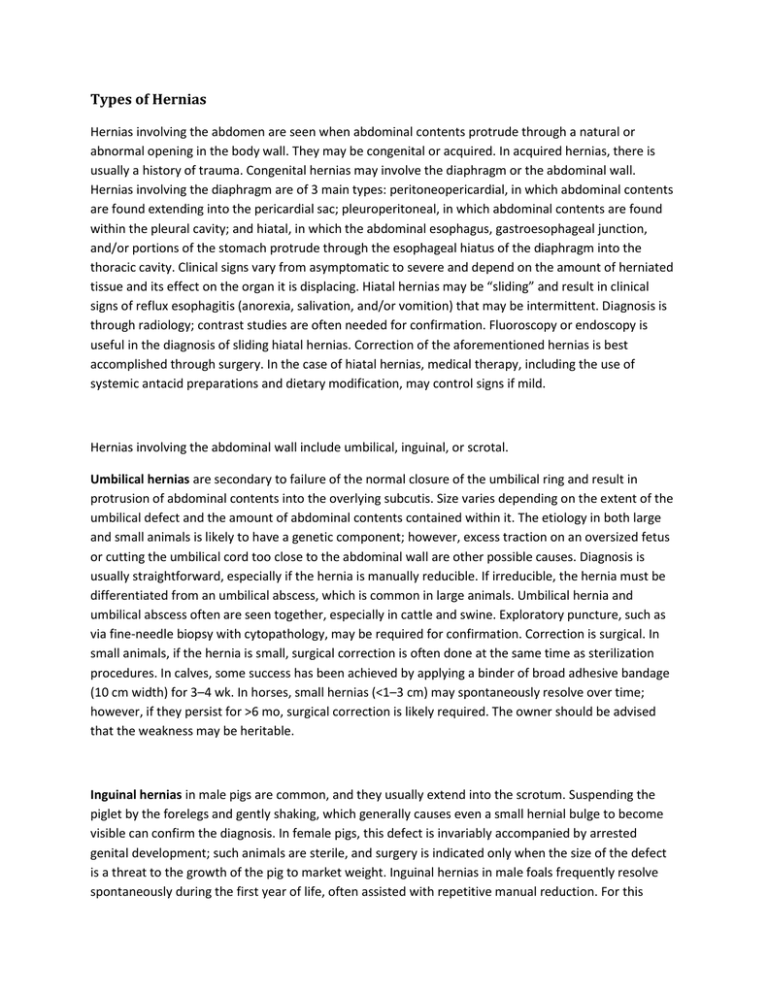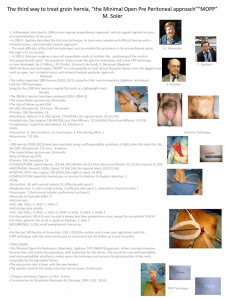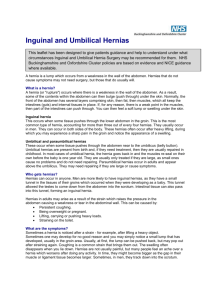Types of Hernias
advertisement

Types of Hernias Hernias involving the abdomen are seen when abdominal contents protrude through a natural or abnormal opening in the body wall. They may be congenital or acquired. In acquired hernias, there is usually a history of trauma. Congenital hernias may involve the diaphragm or the abdominal wall. Hernias involving the diaphragm are of 3 main types: peritoneopericardial, in which abdominal contents are found extending into the pericardial sac; pleuroperitoneal, in which abdominal contents are found within the pleural cavity; and hiatal, in which the abdominal esophagus, gastroesophageal junction, and/or portions of the stomach protrude through the esophageal hiatus of the diaphragm into the thoracic cavity. Clinical signs vary from asymptomatic to severe and depend on the amount of herniated tissue and its effect on the organ it is displacing. Hiatal hernias may be “sliding” and result in clinical signs of reflux esophagitis (anorexia, salivation, and/or vomition) that may be intermittent. Diagnosis is through radiology; contrast studies are often needed for confirmation. Fluoroscopy or endoscopy is useful in the diagnosis of sliding hiatal hernias. Correction of the aforementioned hernias is best accomplished through surgery. In the case of hiatal hernias, medical therapy, including the use of systemic antacid preparations and dietary modification, may control signs if mild. Hernias involving the abdominal wall include umbilical, inguinal, or scrotal. Umbilical hernias are secondary to failure of the normal closure of the umbilical ring and result in protrusion of abdominal contents into the overlying subcutis. Size varies depending on the extent of the umbilical defect and the amount of abdominal contents contained within it. The etiology in both large and small animals is likely to have a genetic component; however, excess traction on an oversized fetus or cutting the umbilical cord too close to the abdominal wall are other possible causes. Diagnosis is usually straightforward, especially if the hernia is manually reducible. If irreducible, the hernia must be differentiated from an umbilical abscess, which is common in large animals. Umbilical hernia and umbilical abscess often are seen together, especially in cattle and swine. Exploratory puncture, such as via fine-needle biopsy with cytopathology, may be required for confirmation. Correction is surgical. In small animals, if the hernia is small, surgical correction is often done at the same time as sterilization procedures. In calves, some success has been achieved by applying a binder of broad adhesive bandage (10 cm width) for 3–4 wk. In horses, small hernias (<1–3 cm) may spontaneously resolve over time; however, if they persist for >6 mo, surgical correction is likely required. The owner should be advised that the weakness may be heritable. Inguinal hernias in male pigs are common, and they usually extend into the scrotum. Suspending the piglet by the forelegs and gently shaking, which generally causes even a small hernial bulge to become visible can confirm the diagnosis. In female pigs, this defect is invariably accompanied by arrested genital development; such animals are sterile, and surgery is indicated only when the size of the defect is a threat to the growth of the pig to market weight. Inguinal hernias in male foals frequently resolve spontaneously during the first year of life, often assisted with repetitive manual reduction. For this reason, early corrective surgery is not indicated unless the hernia is strangulated or of such magnitude that it interferes with gait. Strangulated inguinal hernia in stallions is fairly frequent and is characterized by signs of constant and severe abdominal pain. It is readily recognized by rectal palpation and may be reduced, under general anesthesia, by rectal manipulation. If this fails, immediate surgery is necessary. Inguinal hernias in cattle are rare although sometimes seen in males. Surgical correction to preserve the breeding potential of the bull, when done, is not always successful. Other types of hernias: Diaphagmatic/ Hiatal hernia is a commonly caused by automobile-related trauma in small animals although congenital defects of the diaphragm may also result in herniation (eg, peritoneopericardial hernia). In horses, diaphragmatic hernia may occur, less commonly, congenitally or after trauma, dystocia, or recent strenuous activity. Diaphragmatic hernias are extremely rare in cattle and other species. The signs vary, depending on the duration and species affected. Dogs and cats are characteristically dyspneic in the acute case. If the stomach is herniated, it may bloat and the animal may deteriorate rapidly. In chronic cases, systemic signs such as weight loss may be more prominent than respiratory signs. Physical examination findings may include the absence of lung sounds and/or the presence of GI sounds on auscultation of the thorax. Congenital peritoneopericardial hernia is most frequently an incidental finding, although findings may be related to the respiratory or GI systems or due to compromised venous return to the heart. Horses most frequently present with acute, severe colic secondary to displaced intestines, or respiratory signs and dyspnea. In cattle and water buffalo, diaphragmatic hernias may be associated with traumatic reticulitis and herniation of the reticulum. Careful physical examination, including auscultation and percussion, usually suggests the presence of thoracic disease. The definitive diagnosis is most frequently made from radiographs. Loss of diaphragmatic contour, abdominal viscera in the thorax, and displacement of viscera from the abdomen may be apparent. Radiographic contrast studies may be necessary to make the diagnosis. Surgical repair of the hernia is the preferred treatment. Perineal hernia is a lateral protrusion of a peritoneally lined hernial sac between the levator ani and either the external anal sphincter muscle or the coccygeus muscle.






